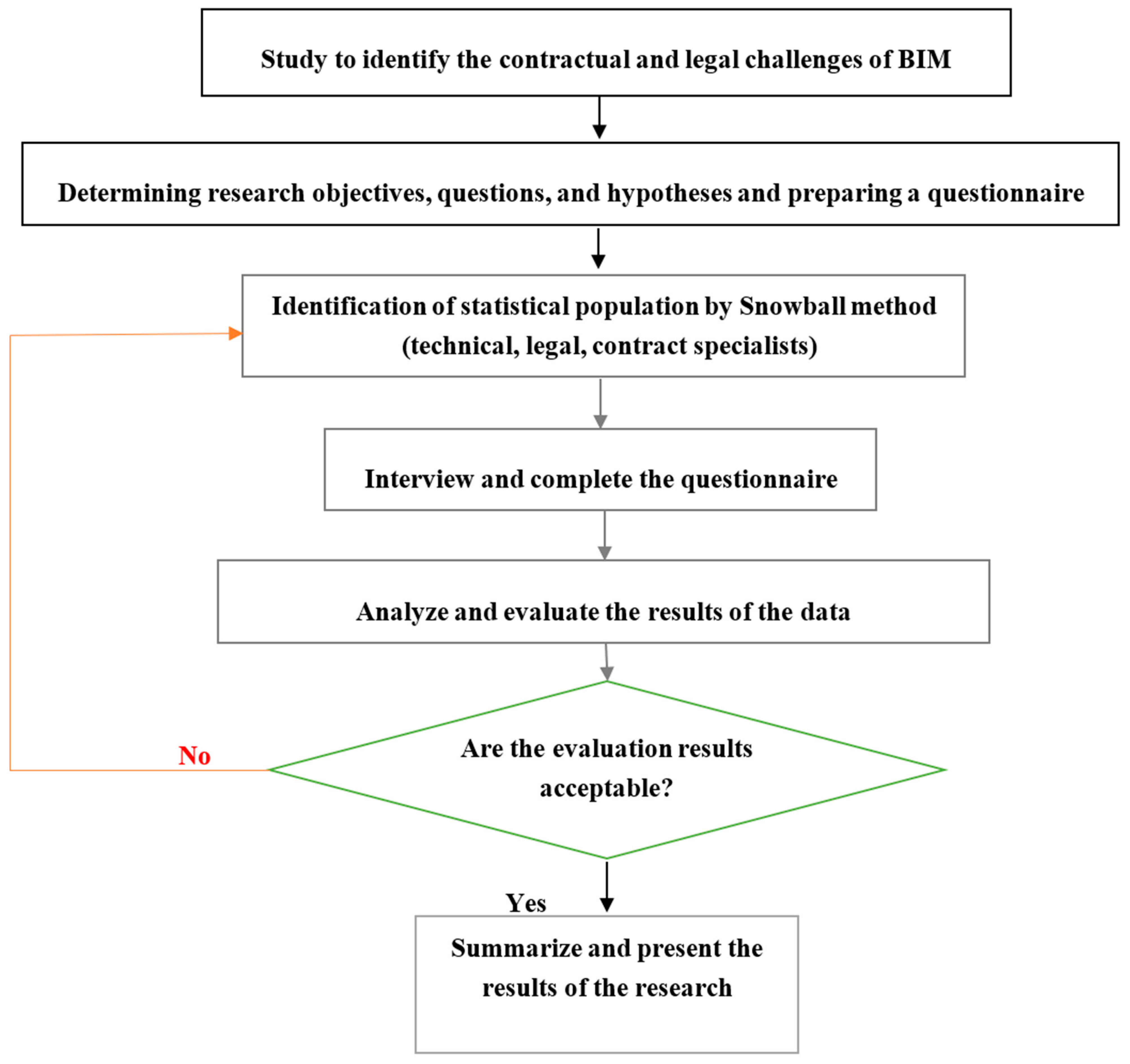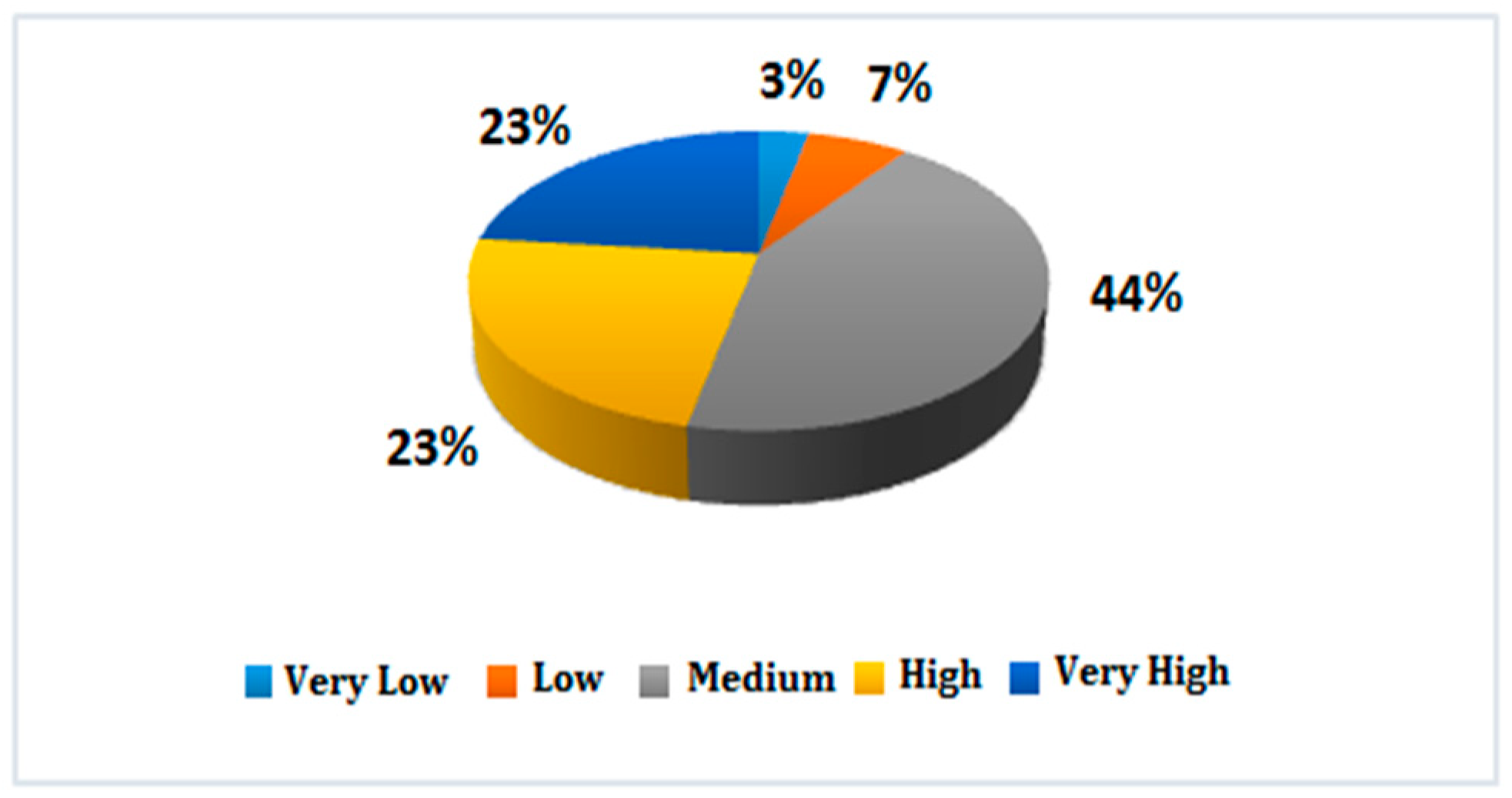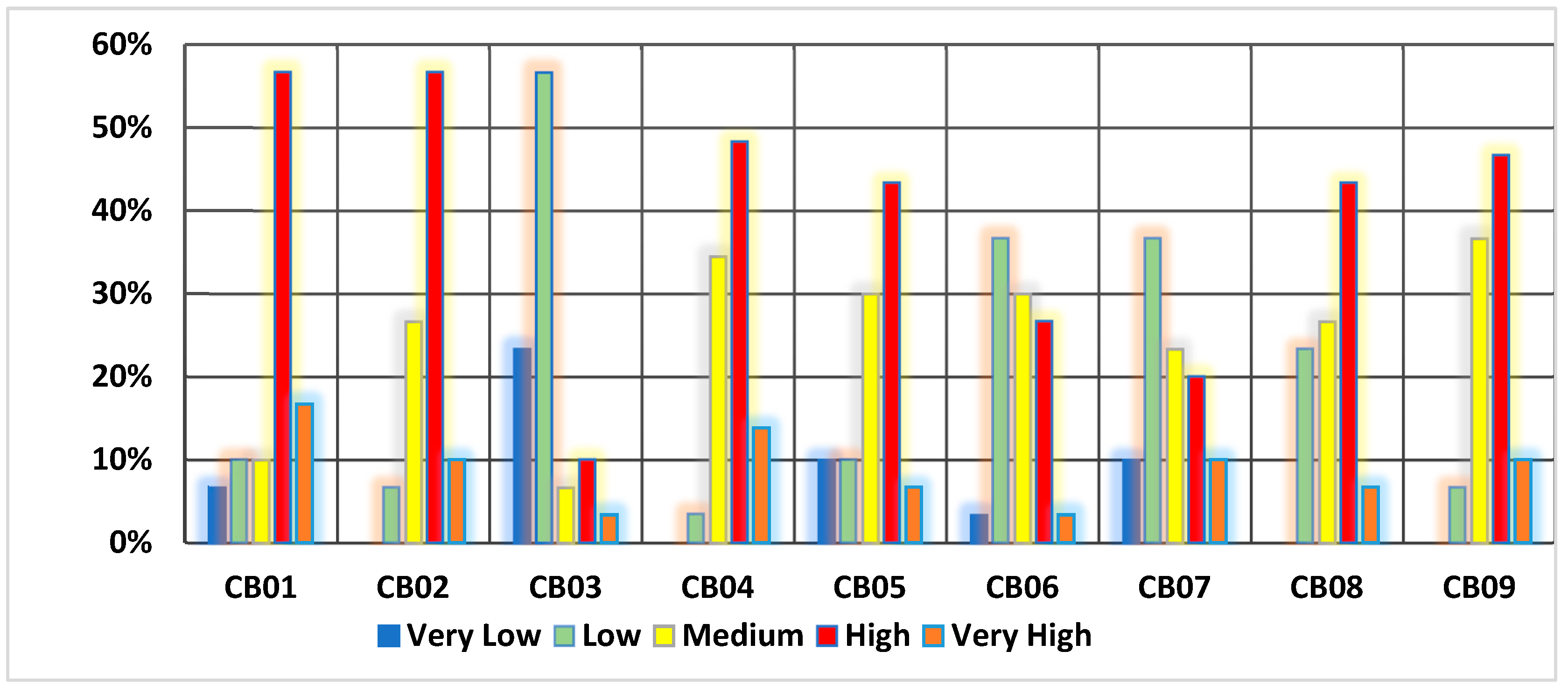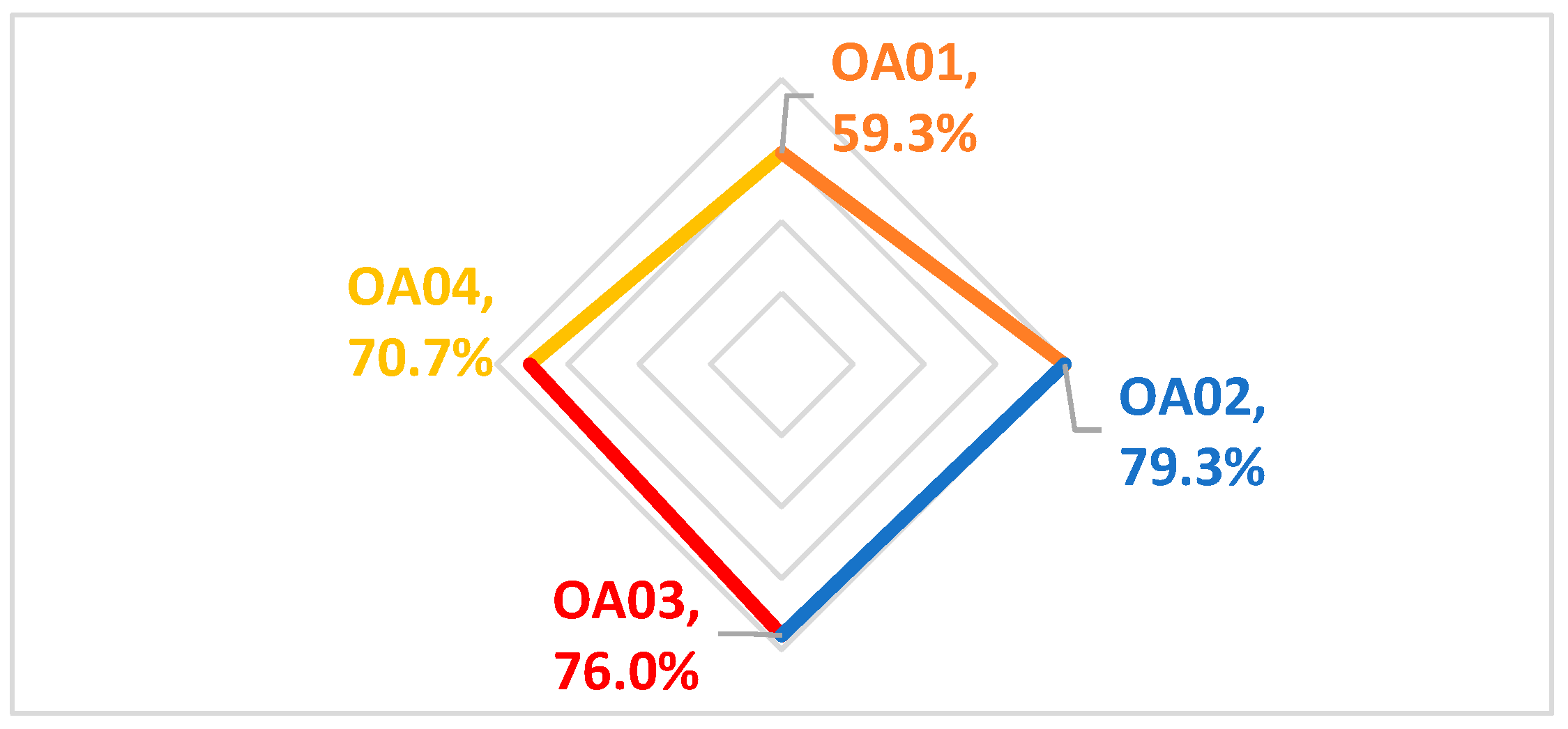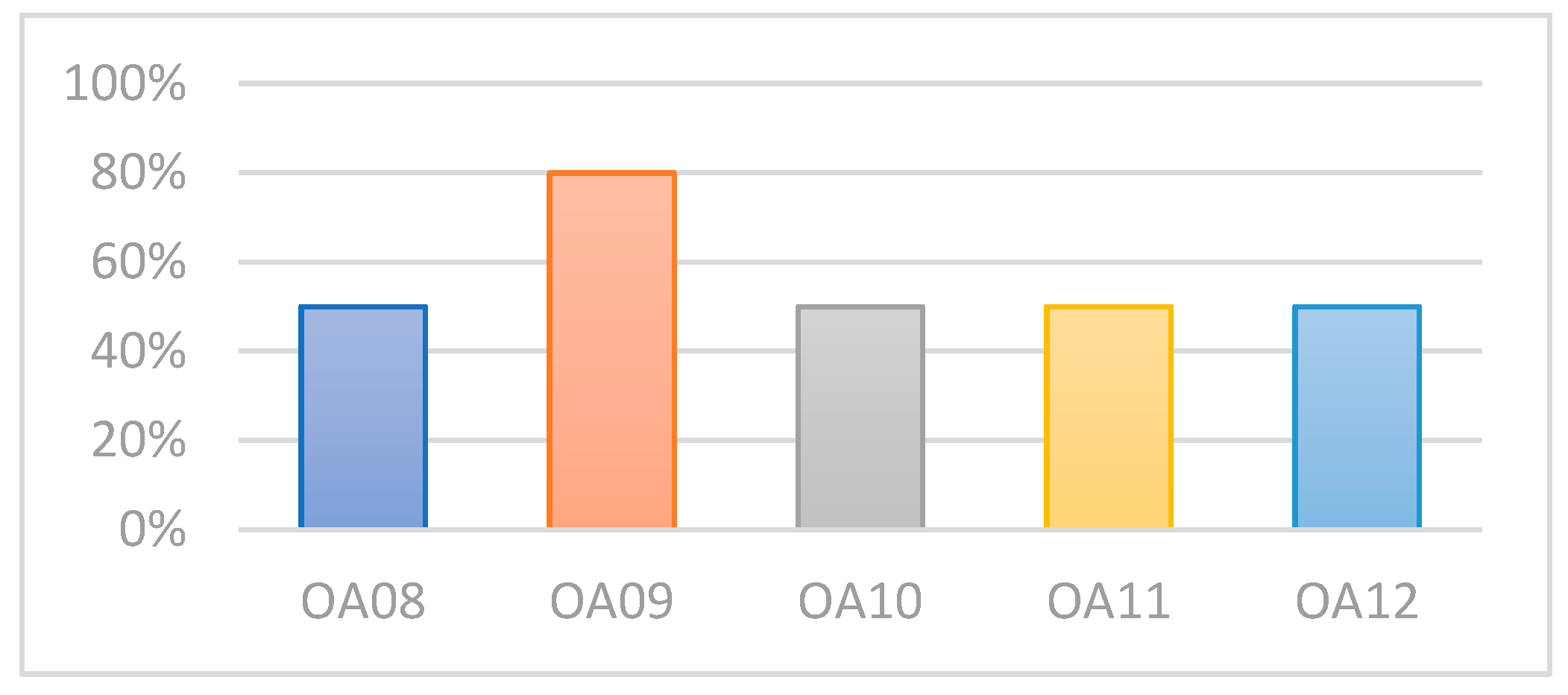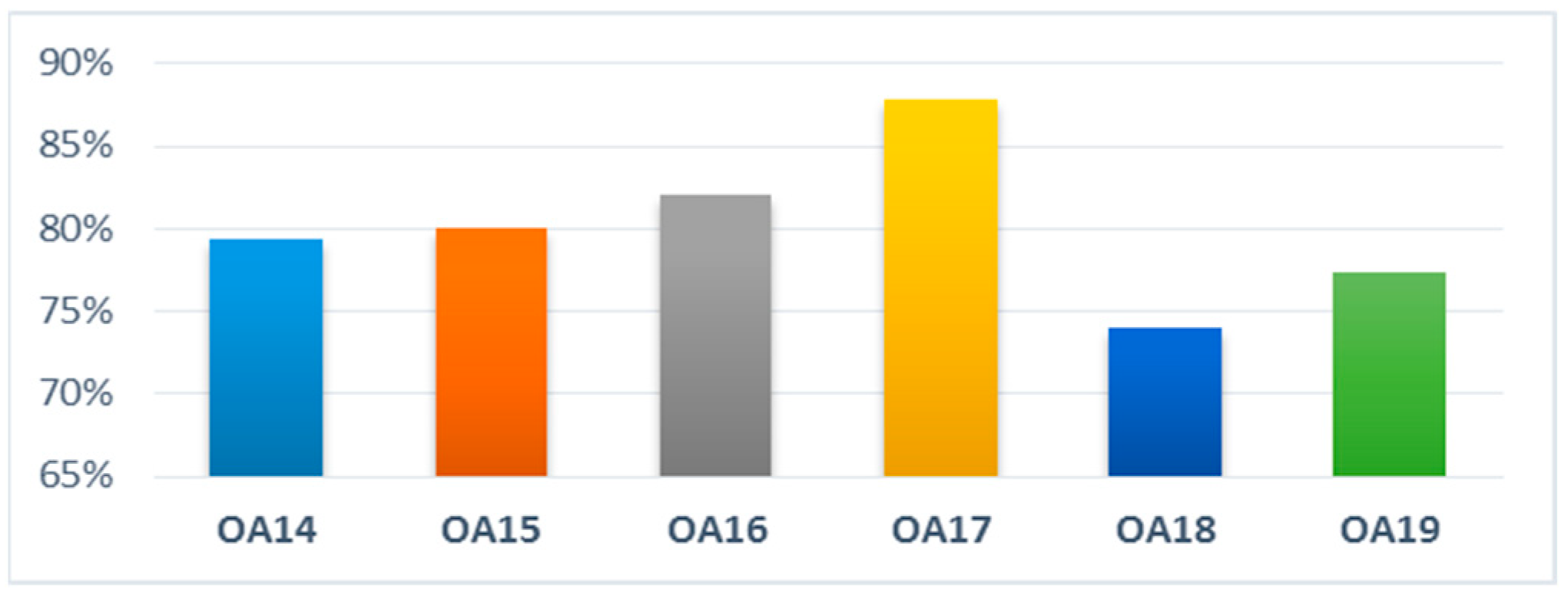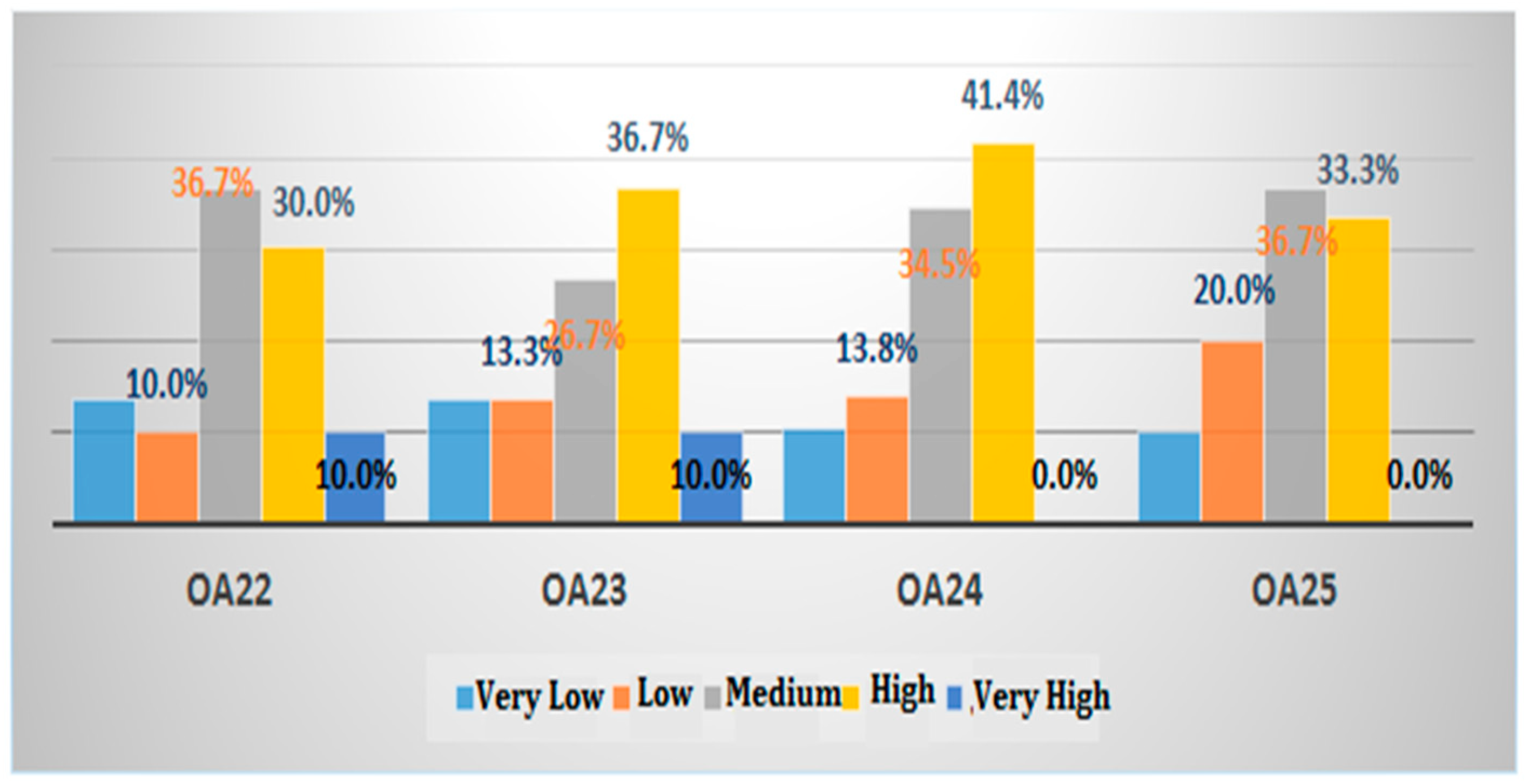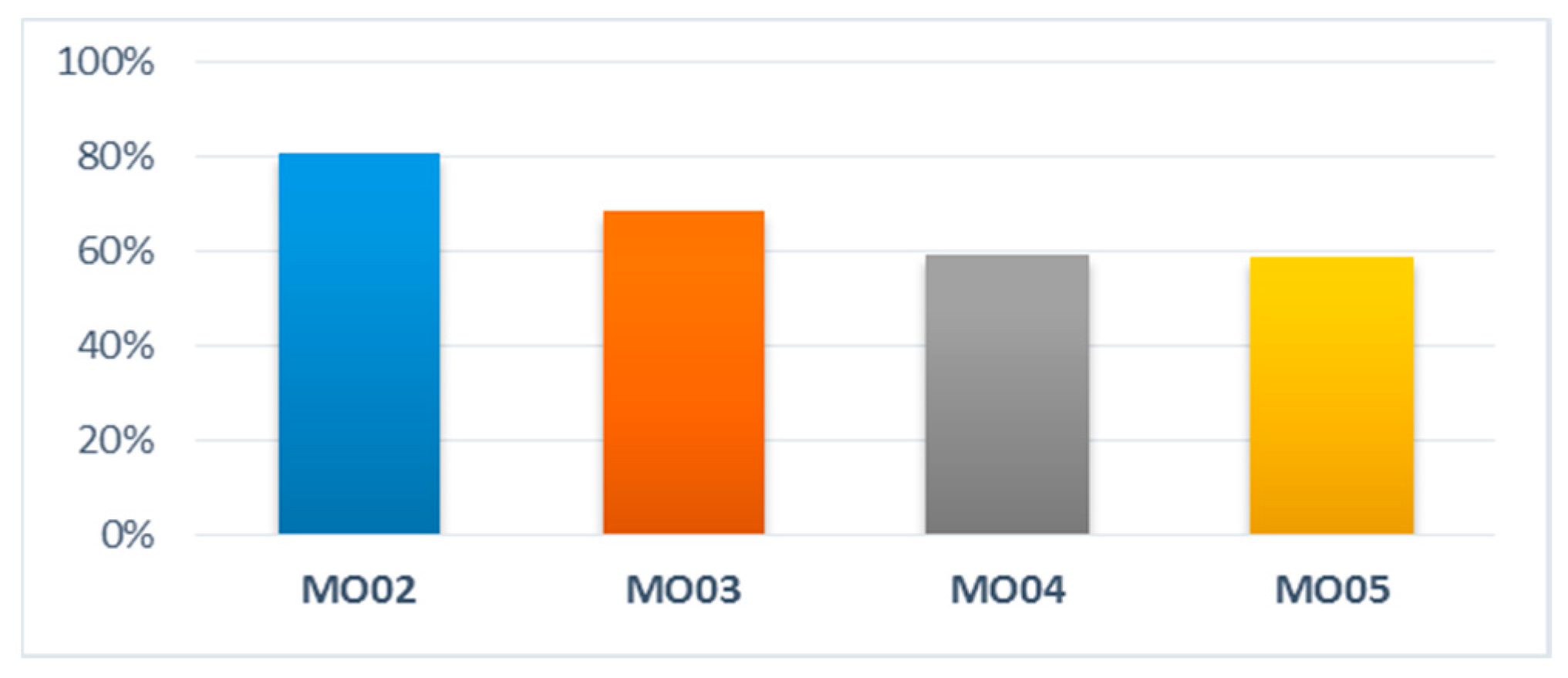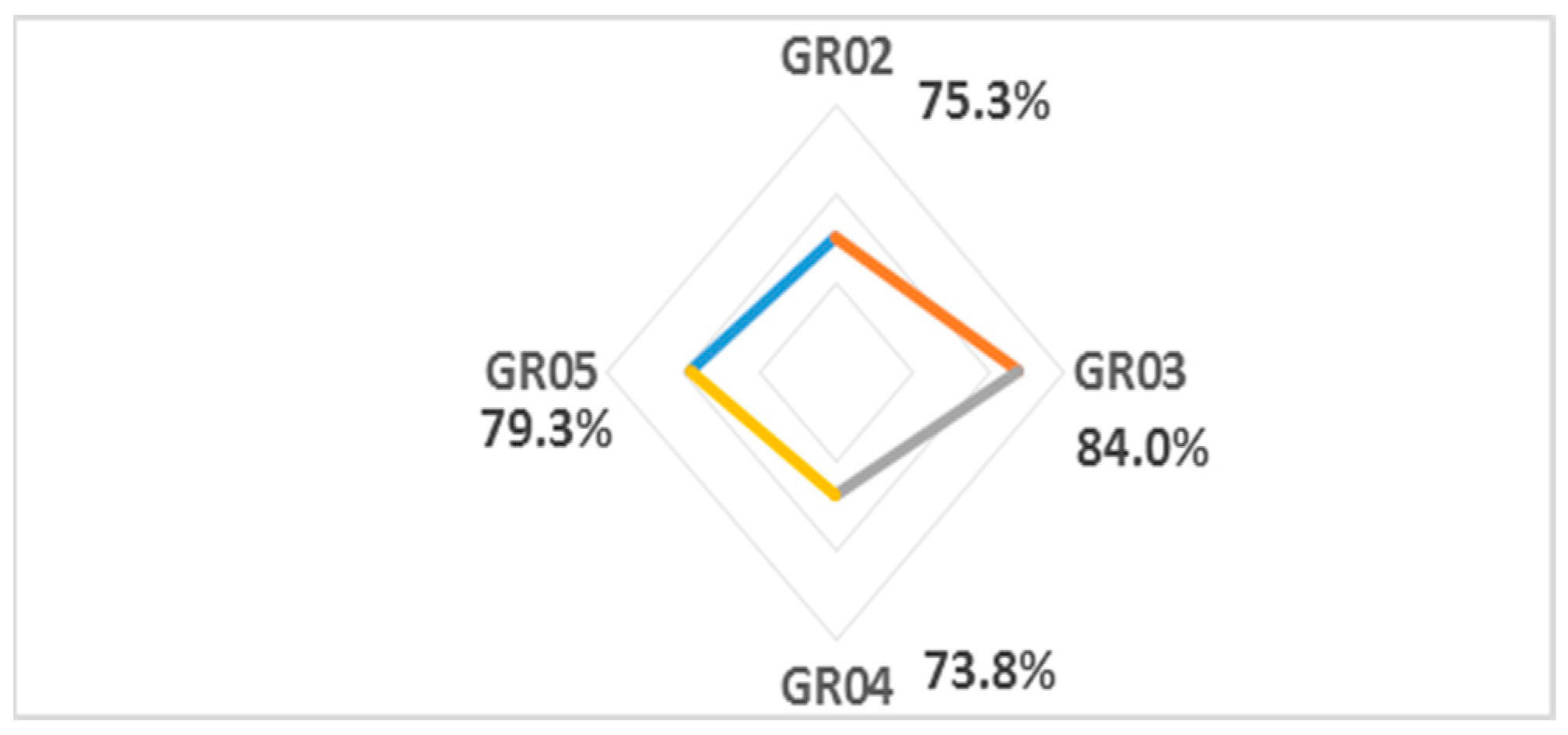1. Introduction
Building Information Modeling (BIM) is an innovative technology that represents a project as a three-dimensional geometric model, connects objects, and integrates them with valuable information such as time and cost [
1]. A BIM is a data-rich, object-oriented, and parametric digital model whose outputs and data are exploited to meet various demands. BIM significantly reduces errors by improving the accuracy and integration of designs [
2]. It is a novel methodology and a cultural change in the construction industry under the approach of integration. The main goal is shared responsibility and project success [
3]. In light of such important advantages, BIM has been increasingly embraced in the construction industry worldwide. However, BIM would not significantly progress in projects until the related legal frameworks and issues are clarified for contract procurement and management [
4].
The construction industry seeks to realize how BIM could be implemented. Apart from various capabilities and advantages, BIM has brought new challenges, including legal and contractual frameworks. Project practitioners need to define their relationships and interactions based on BIM legal frameworks so that their responsibilities are specified. However, the management of BIM-based contracts and legal issues have become a major concern for all stakeholders, and there is still a lack of acceptable contractual frameworks, and research is ongoing [
5]. A BIM contract framework should obligate all the project parties to adhere to the BIM mechanism. Nowadays, the rules and regulations of many countries do not allow for the electronic cooperation of project members in design, construction, procurement, and information sharing. Although a large number of research efforts have been made to BIM implementation enhancement in the construction industry, few such efforts focused on finding BIM contract frameworks [
6]. Several approaches have been examined to tackle contract challenges and issues. Initially, some researchers suggested the use of new types of contracts to implement BIM, but because of the novelty of building information modeling and the many obstacles to its implementation, familiarizing project parties with a new contract type would be a new barrier to implementing this technology. Hence, the contract orientation of BIM was changed, and most countries and researchers viewed the addition of a BIM addendum to the current construction contracts to be a better approach than developing independent contracts [
7]. Apart from the contract framework, the conditions and factors that should be included in BIM contracts to define relationships between the project team members are crucial. The addition of the model (BIM) as one of the essential documents cited by the project will cause many changes in the relationship between the project parties in the BIM addendum contract. Some of the most important of these issues are; priority of the BIM model over other contract documents such as general and private condition of contract and agendas and work order, responsibilities of the employer, consulting engineer, and contractor in possible problems of BIM model, how to approve designs and changes during project implementation, dispute resolution reference in BIM model, the addition of “Information Management” and “BIM Executive Management” teams to each of the parties to the project, the amount and scope of delegation of authority to the parties to the contract by the employer, performance guarantee of each party in the project, case software, project acceptance, intellectual property and copyright, BIM model ownership, and BIM model information security.
This paper examines the existing BIM contracts and then obtains the views of experts and specialists in various fields of work in BIM including engineers, lawyers, employers, consulting engineers, and contractors using the “Snowball method” to determine the most important issues related to Building Information Modeling contracts. The results of this paper will help researchers and organizations studying BIM legal and contractual issues to identify the contractual terms of such projects and analyze the results to better develop the “BIM addendum”.
2. Methodology
2.1. Research Method
The present study aims to explore the features and conditions of BIM contracts and provide the results from the point of view of experts and specialists to develop a suitable BIM contract framework. First, articles and BIM contract documents in seven pioneer countries have been reviewed to evaluate the solutions developed to cope with construction contract shortcomings under specific BIM conditions. To achieve the objectives of the paper, in addition to directly referring to the text of the contracts used in different countries, by conducting a library study, articles and research conducted by researchers in the fields of contract law were also exploited. The library study showed that using “a BIM contract addendum” is the best approach among solutions to solve BIM contract issues. To examine the conditions and features of a suitable contractual attachment, by exploring four similar cases used in the three countries of the United States of America (two cases), the UK, and Singapore (one case each), a proper understanding of the issues that should be considered in this type of BIM contract addendum was identified. Based on the assumption of “a BIM contract addendum” as an accepted contract framework in most countries, the factors that should be considered in such an addendum are evaluated in four groups; BIM contractual basics, BIM contractual obligations and approvals, BIM ownership and copyright, general rules, and other contractual topics. These factors were selected based on the BIM contract literature and expert views.
The statistical population of this research includes multi-disciplinary specialists from technical and engineering experts of the construction industry who have experience in the field of contract law and are also familiar with the structure of BIM. The number of these people is very limited, and it is not possible to identify them easily, so the snowball method was inevitably used to identify them. Snowball sampling is one of the most popular methods of sampling in qualitative research, central to which are the characteristics of networking and referral. The researchers usually start with a few initial contacts who fit the research criteria. The participants are then asked to recommend other contacts who fit the research criteria and who potentially might also be willing participants, who then in turn recommend other potential participants, and so on. Researchers, therefore, use their social networks to establish initial links, with sampling momentum developing from these, capturing an increasing chain of participants. Sampling usually finishes once either a target sample size or saturation point has been reached [
8].
In some research, such as research based on multi-criteria decision making or qualitative studies, we deal with a limited number of experts. In these cases, special considerations must be taken into account, and Cochran’s formula is not an example. The number of samples in qualitative research is small because even a number of more than ten people provide a large amount of information to the researcher, which makes content analysis and perception of views difficult. Some researchers believe that for qualitative studies, a sample of between 5 and 25 people is enough [
9]. Sampling in this type of research is usually done using non-probability methods, and the number of samples is very limited. Nevertheless, the interview process continues until theoretical saturation is reached. Theoretical saturation is the point where the researcher realizes that nothing new can be said. Research shows that an array of approaches to assess saturation that demonstrate saturation can be achieved in a narrow range of interviews (9–17) or focus group discussions (4–8), particularly in studies with relatively homogenous study populations and narrowly defined objectives [
10].
The number of experts who can be included in the sample to complete the questionnaire is limited based on various factors, such as the specialization of the questions and the time-consuming process of the questionnaire. Considering the familiarity of the researchers with a number of specialists who are in this community (managers, university professors and contract affairs experts who are also familiar with BIM) and the possibility of introducing a number of other specialists in this field by the participants in completing the questionnaire, the sampling method of the current research was the non-random snowball sampling method of thirty experts in this field.
In order to obtain the opinion of contract experts and specialists in the construction industry, a questionnaire was developed, the validity of which was approved by experts in the field of construction industry law. As a result, the present study applied the snowball sampling method to select a perfect set of expert participants in engineering, legal, and contract aspects and collect data as there was no predefined statistical population. As explained in
Section 2.3 Statistical population and sampling the questionnaire was given to a group of experts in the construction industry, who have experience in construction and infrastructure projects and are familiar with BIM technology, in different work domains (employer, consultant engineer, contractor, university). The characteristics of the respondents are described in this section. The results were collected from April to June 2021, and then statistical and qualitative analyses were performed on the opinions received.
The reliability of the questionnaire was assessed using Cronbach’s alpha, the results indicate its high level of reliability. The findings from the questionnaire and the review of BIM contracts were analyzed, identifying factors that should be considered in BIM contracts. The research method of the article is summarized in
Figure 1.
2.2. Questionnaire
As mentioned, several solutions have been introduced to solve BIM contract issues across the world. Such solutions continue to be complemented and developed. The present study aims to provide a detailed discussion of the conditions and factors that should be considered in BIM contract frameworks. The views of construction and BIM experts are the most important way of identifying such factors. To collect expert views, a questionnaire was designed. The questionnaire indexes were determined by reviewing contractual and legal challenges in BIM and the current contract frameworks. Then, the selected experts with project-oriented contract and BIM experience were interviewed to modify and complement the questionnaire. The resulting questionnaire involved two categories, seven factors, and a total of 58 questions, including 11 questions on personal information and familiarity with the topic of research. The remaining 47 questions related to four factors, including IM contractual basics, BIM contractual obligations and approvals, BIM ownership and copyright, general rules, and other contractual topics. The questionnaire was based on the five-point Likert scale, where 1, 2, 3, 4, and 5 represented very low, low, medium, high, and very high, respectively.
To evaluate the results, the percentage of the frequency of responses has been compared with each other and only in the indicators of the general rules of BIM contracts questions (the level of responsibility of each project member in information security) (code GR02-GR05) the weighted average of the frequency of responses has been used.
2.3. Statistical Population and Sampling
The subject of the present study involves BIM, engineering, legal, and contract areas. Hence, the statistical population consisted of experts in construction and civil/infrastructural projects, academic law and contract experts, contracting companies, design and consultant engineers, and construction employers. The number of contractual law specialists in construction companies is very limited compared to other experts. This makes the statistical population of this research much smaller than the experts active in the construction industry.
Regarding to the newness of this technology and due to the lack of experts who have mastered BIM contractual issues, contract law specialists who are in the companies of consultant engineers, contractors, and other persons who are active in the field of BIM were identified and finally using The snowball method was used to develop the sample size.
Table 1 describes the respondents.
The respondents involved 23 civil engineers and architects and 7 lawyers and contract affairs experts with academic expertise (90% of which had Master’s or Ph.D. degrees). A total of 63% of the respondents had work experience of longer than 11 years in construction. This further supported the reliability of the responses. The respondents had very good familiarity with contract affairs and construction contracts; more than 47% of the respondents had high or very high familiarity with construction contracts. Thus, their views of contract frameworks and factors that must be considered in BIM rules are reliable.
Figure 2 illustrates the diagram of contract familiarity among the respondents.
2.4. Legal and Contractual Factors and Indexes
To realize the views of the respondents, five categories of the questionnaire were focused on contract and legal factors of BIM. A total of 47 questions were developed to collect data. To facilitate data analysis and conclusion, a code consisting of two Latin letters and two digits was assigned to each question.
Table 2 describes the coding of the questions.
2.5. Validity and Reliability of the Results
Although expert views had been exploited to develop the questionnaire indexes, the questionnaire results were delivered to seventeen experts in order to check the face validity, and their opinions regarding its appearance and form were obtained and the necessary corrections were applied. Then, to control the content validity of the questionnaire, it was given to five specialists in the field of BIM contracts, and after receiving their feedback and corrections, the questionnaire was finally approved.
The reliability of the questionnaire was examined using Cronbach’s alpha. Alpha was calculated to be 0.965 in SPSS, indicating excellent reliability.
Table 3 and
Table 4 show the details of related calculations.
3. BIM Legal and Contract Challenges
BIM is an emerging technology in construction. Despite several advantages and appealing capabilities, the legal and contract challenges of BIM may act as a barrier to the expansion of BIM utilization. BIM utilization management is a challenging task and has no certain structure. This brings several legal issues in the lifecycles of projects [
11]. Thirty-six BIM implementation challenges were identified in the USA. The major challenges included employee training, the lack of national BIM standards, and software interoperability [
12]. BIM is widely employed for projects in Taiwan. The most important BIM legal issues in Taiwan were found to be software pack incompatibility, defective software errors, intellectual property issues, and construction contract issues [
13]. Construction is a highly dynamic industry in the Persian Gulf region. The use of BIM encounters many problems in the Gulf region. It was shown that the main challenges of BIM utilization were organization, technical, government and legal, and environment [
14]. BIM legal issues have been recognized as a BIM challenge at national and international levels [
15]. While BIM has a growing trend in the world, design consulting engineers, contractors, and sub-contractors are concerned about the risks and obligations of BIM in many countries. BIM requires a new set of legal instruments to fulfill its promises [
16]. Suitable contract conditions that clarify the moderate responsibilities and obligations of the contract parties are a major component in successful BIM implementation [
17]. The standards and technical specifications of BIM lead to the increase of project information and affect the cooperation between its members. The legal obligations of BIM on intellectual property, model ownership, and data ownership are not clarified. These issues should be resolved in the contract in order to avoid future disputes [
18].
In traditional construction practices, e.g., design-bid-construction, design responsibilities are assigned to a single individual, e.g., an architect, structural engineer, or facilities engineer, and the contractor is in charge of construction [
4]. However, the design is performed collectively under BIM, and the model is not directed or supervised by other individuals; moreover, responsibilities could be distributed among construction members [
19]. Engineers are not the only individuals to learn how to work in BIM. As with designers that can build their BIMs, lawyers and other experts attempt to participate and establish legal BIM relationships. Therefore, it is required to understand legal issues and aspects when constructing projects relying on a BIM work circulation [
20]. BIM legal and contract issues and challenges were studied in the UK, and the results were ranked in sixteen important topics. It was demonstrated that model ownership, contractual relationships between the BIM parties, and design responsibility were the most important BIM concerns [
21]. BIM legal and contract aspects were classified into (1) procurement system incompatibility, (2) BIM-induced responsibilities, (3) model ownership and copyright, and (4) unknown rights and responsibilities [
19].
The understanding of how BIM could be utilized in a project enables a suitable contract. In this regard, BIM has two distinct characteristics from traditional construction practices: (1) BIM can be a source of information for the project (as a single datum or a set of integrated or interrelated data), and (2) the contract parties can help create an integrated or multiple virtual model as a part of the BIM process [
15]. The current legal frameworks for providing professional services in the architectural, engineering, construction, and operation (AECO) sectors have dispersed contract texts compared to contract risks in e-commerce [
16]. Thus, AECO agreements or contracts should be considered more carefully. Moreover, legal issues are different at different BIM maturity levels, and it is required to generate protocols and instruments to handle such issues [
22]. Furthermore, legal issues and solutions may be different in different regions [
19]. As can be seen, contracts and legal issues are a major problem in the utilization of BIM in the construction industry. Several solutions have been proposed to tackle such problems, which are discussed below.
Through national standards, government organizations develop frameworks to help BIM adoption. These documents define how BIM will be used at all stages of the design and construction process, what software to be used and what information should be provided during each process, and other aspects of the BIM case. Most of these documents are descriptive, however, some of them are mandatory. The goals and visions of the Guidelines, roadmaps, execution plans, protocols, and mandates differ from one another. The producers of these documents do not follow a uniform procedure for choosing their names, with some mandates being called “guidelines” or “standards”. In most cases, at the beginning of each of these documents, it is explained whether they are descriptive or prescriptive.
4. BIM Guidelines and Standards
In construction projects, the development of construction information modeling leads to the formation of corresponding documents. Some studies on contractual, and legal matters and contrasts between dignitaries of the project were conducted in various countries. The result is the codification of standards, guidelines, contracts, and technical and legal conditions to determine the duties of the project’s parties in building information modeling. Because these tools are brand new, bugs and problems gradually appear, and experts and beneficiaries seek solutions.
Several countries have defined standards so that the people involved in building information modeling can set their equations based on them. In the USA, the first section of building information modeling was published in 2007 by “The National Institute of Building Sciences (NIBS).” In April 2010, the second edition of the BIM project utilization was published in the USA. The Associated General Contractors of America (AGC) and The American Institute of Architects (AIA) took a number of actions concerning the edition of BIM contracts, which are covered in the next section.
Finland gathered some documents and guidelines to apply this technology. One of these documents is “BIM Common Billing Requirements 2012”, which was provided based on the requirements published by Senate Properties in 2007. Managing and hiring Finland government properties is the responsibility of Senate Properties, which falls under the supervision of Finland’s economic ministry. “BIM Common Billing Requirements 2012” journals collection is the result of a broad project edited based on COBIM. “BIM Common Billing Requirements 2012” is provided based on the experience of previous guidelines of management organizations and users’ experience [
23]. This collection includes 13 series:
General Part
Modeling of the starting situation
Architectural design
MEP (Mechanical, Electrical, and Plumbing) design
Structural design
Quality assurance
Quantity take-off
Use of models for visualization
Use of models in MEP analyses
Energy analysis
Management of a BIM project
Use of models in facility management
Use of models in construction
Additionally, three series of General Infra Model Requirements and Instructions, the open Inframodel data exchange format developed in Finland, and the InfraBIM Classification System were edited. These guidelines were developed and tested in several experimental projects. The “Common InfraBIM requirements YIV2015” is another guideline related to BIM guidelines in infrastructure projects. InfraBIM requirements (1–7 volumes) were published on 5 May 2015 by BuildingSMART Finland. The first draft of these requirements was provided between 2010 to 2014 by participants in InfraFINBIM of the RYM Oy project. Using modeling effects, project organization, phasing, timing, process, and information exchange, the project manager will be able to analyze how to use information modeling to maximize surplus value and meet the project’s goals [
24]. Inframodel is an open method based on the LandXML method and is used for information exchange of the infrastructure. The first edition of Inframodel3 includes details for ground models, underground surfaces, road geometry, railways, and construction layers. In addition, it covers sewage and water supply. Inframodel explains the common method to use LandXML in Finland. In early May 2014, Inframodel was considered to be the information exchange format in the traffic agency of Finland and large cities [
25].
The UK presented its first edition of the BIM standard, named “AEC (UK) BIM Standard,” in November 2009. In 2010, another edition of this standard was published for using Revit software to create information models of buildings. Experts from different companies in the building industry from England participated to provide this standard. It is used to guide and support a specific method for conducting construction projects. It is compatible with the Revit software system in addition to the FIDIC (The International Federation of Consulting Engineers) contract system [
26]. The ISO 19650 standard is an international standard for managing information over the whole life cycle of a built asset using building information modeling (BIM). It contains all the same principles and high-level requirements as UK BIM Framework and is closely aligned with the current UK 1192 standards [
27].
BS EN ISO 19650-1: Concepts and principles.
BS EN ISO 19650-2: Delivery phase of the assets.
BS EN ISO 19650-3:2020—Operational phase of the assets.
BS EN ISO 19650-4:2022—Information exchange.
BS EN ISO 19650-5:2020—Security-minded approach to information management.
These standards are founded on the UK’s standards for information management using building information modeling, namely BS 1192:2007 + A2:2016 and PAS 1192-2:2013. PD 19650-0-UK Transition Guidance was also published alongside the standards, which will, along with the UK National Forewords and National Annex, aid the implementation of the ISO standards in the UK.
Singapore focused on developing the usage of building information modeling. The aim of using building information modeling in Singapore is to enhance efficiency in the building industry. In buildings with substructures larger than 5000 m
2 it is compulsory to use BIM [
28]. Therefore, in 2010, 2012, and 2013, the first and second editions of the “Singapore BIM Guide” was presented by Building and Construction Authority (BCA). A specific protocol was published following the BIM contract for the users of the building information modeling. The primary edition of this protocol, named “BIM Particular Conditions,” was published in 2010, and the second one was published in 2015. Basically, it is an attachment to the contract of the parties to a project that outlines how the parties are required to use building information modeling in the contract. In addition, the “ BIM Essential Guide For BIM Execution Plan” was provided by Building and Construction Authority (BCA) in Singapore in 2013 [
29].China has also taken important steps in the field of building information modeling. For the first time in 2007, the China Institute of Building Standard Design and Research presented the Building Objects Digital Standard. In 2012, the Ministry of Housing Urban-Rural Construction revised the building standards and published five standards related to building information modeling. These five standards are; Uniform Standard for the Application of Architectural Engineering Information Model, Storage Standard for Architectural Engineering Information Model, Delivery Standard for Architectural Engineering Design Information Model, Classification and Coding Standard for Architectural Engineering Design Information Model, Application Standard for Manufacturing Industry Engineering Design Information Model [
30]. Recently published research shows that, between 2011 and 2021, 77 national policies and standards, and 687 local policies and standards associated with BIM technology have been prepared in China [
31].
5. BIM Contract Framework
BIM is based on the cooperation and participation of project team members. BIM is intrinsically and heavily dependent on data that are created and shared by various project members. Hence, it requires more cooperation of the project members than traditional projects. The clarification of contractual topics and the conditions and obligations of the contract parties is a crucial requirement in BIM implementation. Apart from execution agendas and instructions, contractual topics are handled in most countries for BIM implementation. Although there is consent on the development of BIM-specific contract documents, there is no standard and solid approach to the obligations and requirements or the part of the contract where BIM documents should be included. In general, it can be said that research on BIM contracts and their legal aspects is in its infancy [
11]. The integration of BIM contractual conditions in the current construction contracts is the most primary legal topic [
17].
The American Institute of Architects (AIA) published the AIA Document C106
TM agreement in 2007. It specified the utilization and transfer of digital data between project parties. The next version of the agreement was revised in 2013 [
32] and recently, its latest version was released in 2022 [
33]. AIA Document C106–2022 provides a licensing agreement for two parties who otherwise have no existing licensing agreement relating to the use and transmission of Digital Data. C106 allows a Transmitting Party (1) to grant a Receiving Party a limited non-exclusive license for the Receiving Party’s use of Digital Data on a specific project, (2) to set forth procedures for transmitting the data, and (3) to place restrictions on the license granted. C106 provides for the Receiving Party to compensate the Transmitting Party for the Receiving Party’s use of the Digital Data [
34]. Moreover, the AIA published the AIA Documents E201
TM-2007 [
35] whose latest version is E 201™-2022 (BIM Exhibit for Sharing Models with Project Participants, Where Model Versions May be Enumerated as a Contract Document) [
34]. The AIA Document E202 exhibit was published in 2008, It specified model content requirements at five levels, determining the development, creation, and legal utilization of model content at each level [
36] its latest version was published in 2022. The AIA Document E203
TM-2022 (Building Information Modeling and Digital Data Exhibit), E401™-2022 (BIM Exhibit for Sharing Models Solely Within the Design Team), E402™-2022 (BIM Exhibit for Sharing Models Solely Within the Construction Team), AIA Document G201
TM-2013 (Project Digital Data Protocol Form), AIA Document G202
TM-2013 (Project Building Information Modeling Protocol Form), G203™-2022 (BIM Execution Plan), G204™-2022 (Model Element Table), G205™-2022 (Abbreviated Model Element Table) are among other BIM-related documents published by AIA [
37]. They specified the basics of digital data communication and expectations from BIM, digital data protocol documentation, and modeling protocol documentation [
38]. Associated General Contractors of America (AGC) published the BIM addendum in cooperation with a number of contractors in 2008. This addendum is applied to construction contracts and specifies particular BIM conditions. The latest version of this addendum was published in 2017 [
39]. These addendums change standard contract conditions and modify BIM-related aspects that are beyond the initial scope of the agreement. This maintains contractual relationships between the main project members (i.e., the employer, consulters, and contractors) and avoids major changes in their responsibilities [
7].
The UK developed the BIM standard in 2009 and then published a BIM Protocol in 2013. The latest revision of the protocol was applied in 2018 In the UK, building information modeling is governed by BS 1192-2, the standard for building information modeling. According to its introduction, it supports BIM Level 2 for all common construction contracts. By identifying the building information models provided by the project team, this protocol identifies commitments, responsibilities, and limitations [
40]. In Digital Built Britain-Level 3 Building Information Modeling-Strategic Plan, it was stated to create a new framework for projects provided by BIM to ensure integrity, avoid confusion, and encourage common work [
41].
As with many other countries, the UK specifies the contractual responsibilities of the project parties by adding the BIM protocol rather than developing a comprehensive, independent contract. In the European Union, the ARCHITECTS’ COUNCIL OF EUROPE published “AN INTRODUCTION TO BIM” in 2019. The purpose of this guide is to give some answers on how to deal with the challenge of rapidly progressing digitization in the construction industry. The guide aims to give advice on how to deal with challenges that emerge when a project is to be designed using BIM and provide an example of what can be considered as established practice when working with 3D software and BIM related processes [
42]. The guide provides explanations regarding the requirements and features that should be considered in ICT and BIM contracts. The guide includes eight sections with these titles; CONTRACTS AND SCOPE OF SERVICE-SCOPE OF SERVICE VERSUS LOD (LEVEL OF DEFINITION)-MODELLING PRACTICE-CLASSIFICATION/TYPOLOGY-LOG (LEVEL OF GEOMETRY)-LOI (LEVEL OF INFORMATION)-DOCUMENTATION, DESCRIPTIONS, 2D DRAWINGS AND REFERENCES-LEGAL MATTERS.
In April 2013, Germany’s Federal Ministry of Transport and Digital Infrastructure (BMVI) founded the “Construction of Major Projects Reform Commission” an initiative aimed at ensuring “the public develops greater confidence in major projects, that public funds are spent efficiently and that the good international reputation of the German planning and construction industries is preserved.” [
43] In 2015, the German Ministry of Transport and Digital Infrastructure defined a comprehensive roadmap for the stepwise introduction of BIM methods with the goal to make BIM mandatory for federal infrastructure projects in 2020 [
44]. The Association of German Engineers (Verband Deutscher Ingenieure-VDI) is authorized to produce legally building standards such as the VDI2552 series. In the VDI 2552 series of guidelines on BIM, 11 parts-some with sub-parts-have been planned or published so far. The VDI 2552 series of guidelines–consisting of rules of technology that have already been tried and tested internationally–combines all the basic information about BIM: from the basics and uniform terms to aspects such as data management, classification systems or settlement plans, to the processes and qualifications of those involved. The series of guidelines is aimed at everyone involved in BIM processes, as well as at manufacturers of software or components, auditors, experts and tenderers [
45].
Singapore developed BIM contract conditions in 2012 and revised them in 2015 [
46]. Australia and China have initiated specific addendums for the adaptation of new conditions in BIM for construction projects [
7].
The Ministry of Housing and Urban-Rural Development (MOHURD) of the People’s Republic of China (PRC) has been publishing construction project contract editions since 2010. Building information modeling technology in China has been combined with the current state and development to make the rights and commitments of the active groups in the project obligatory as contract attachments. These attachments provide some versions of the contract that simplify the use and improvement of BIM technology in engineering projects. National ministries and industrial associations founded and developed the documents of the contract that corresponded to the condition of China, which are attached to the current contracts of the project [
26].
The standard contract is applied to all construction projects in China. On 25 Nov 2020, the Ministry of Housing and Urban-Rural Development of the People’s Republic of China (MOHURD) issued the standard contract for construction projects: The requirement of Building Information Modelling (BIM) become part of the general conditions of the China Government’s standard of the construction project contract. The BIM requirements, as part of the conditions in the standard contract, are mandatory to adopt and follow [
47].
Some other countries have developed BIM utilization standards or instructions and included BIM contractual features to provide proper contractual conditions.
Table 5 summarizes the contract approach used in the three pioneers BIM countries.
The solutions that have been proposed to solve BIM contract issues are divided into two groups: (1) developing an independent BIM contract, which has been poorly accepted, and (2) developing a BIM addendum, which has been adopted by many organizations and countries. Such an addendum is developed based on the conditions of each country and added to the standard contracts to adapt them to specific BIM conditions. In general, the advantages and disadvantages of each of these solutions can be categorized as follows;
Independent BIM contract: An independent contract for implementing BIM is prepared and used by the project agents (employer, designer, contractor). The most important advantage of this method is the possibility of completely redefining the contractual terms of BIM for each of the project parties (employer, consultant, contractor) and changing the responsibilities of each of them according to the characteristics of building information modeling. Despite this advantage, the biggest problem is the need to prepare new contracts for each of the project parties and the lack of familiarity of their users, creating an obstacle to the implementation of BIM with the addition of new contractual ambiguities, changes in the responsibilities and risks assigned to the project agents and new differences can be seen in it.
BIM contractual annex: By adding the BIM contractual annex to the existing standard contracts, their conditions are changed and BIM-related issues that are beyond the scope of the existing agreements are answered. One of the biggest advantages of this solution is adding a special BIM addendum to existing contracts without the need to draft new contracts. Another advantage of this method does no need to redefine the employer-consultant and employer-contractor contracts. Furthermore, the familiarization of the project agents with the existing contracts and the absence of new ambiguities, and the preservation of confidential issues between the employer, the designer, and the contractor are the advantages of this approach compared to the previous method. Despite these advantages, limitations in fundamental changes and relying on the basics of existing standard contracts, which do not include BIM conditions, are among the weaknesses of this solution.
Due to complexities, unfamiliarity of project practitioners with the entire BIM aspects, and increased ambiguity when using a new, unknown model among project practitioners, most countries and BIM-related organizations prefer to include an addendum to the current construction contracts so that the current contract frameworks would be maintained while including the BIM addendum [
7].
6. Results and Discussion
6.1. Contractual Basics of BIM (CB)
This factor involved nine questions coded as CB to collect the views of the respondents on the contractual basics of BIM. In particular, the questions emphasized the contract frameworks in the construction industry and how they could be adapted to specific BIM rules.
Table 6 reports the CB questions.
6.1.1. Contractual and Legal Issues and Contract Solutions in BIM
Question CB01 measured the importance of BIM familiarity of construction practitioners in the view of the respondents. In all, 73% of the respondents viewed the importance of familiarity with BIM to be high or very high. This suggests that it is very important to train this technology to construction practitioners. Furthermore, 67% of the respondents described the importance of contract and legal issues in BIM utilization in the construction industry (CB08) to be high or very high. The adaptability of the current construction contracts to BIM utilization (CB03) was very low or low in the view of 80% of the respondents. This implies a necessity to develop BIM-specific contracts in a wide range to meet the requirements of this technology.
Additionally, 62% of the respondents considered the inclusion of BIM addendums in the typical contracts to have high or very high effectiveness (CB04). Finally, 50% of the respondents viewed developing independent BIM contracts to be of high or very high effectiveness (CB05). These findings are consistent with BIM contract solutions in many countries [
7].
6.1.2. The BIM Model Position on Contracts
Questions CB06 and CB09 evaluated the priority of the BIM model over other contract documents (agreement, general conditions of contract, special conditions of contract, agendas, and work orders) and its position in the contract. The respondents considered the BIM model to have a higher priority over “agendas and work orders” and “special conditions of contract” and lower priority than “general conditions of contract” and “agreement.”
Figure 3 shows the bar charts of the responses to the contractual basics of BIM questions.
6.2. Contractual Obligations and Approvals of BIM (OA)
This factor included 25 questions coded as OA. These questions evaluated the contractual obligations and approvals of project team members (e.g., employer, consulting engineers, contractors, sub-contractors, and suppliers) in BIM with a focus on the components of a BIM contract framework.
Table 7 represents the OA questions.
6.2.1. Responsibilities of Project Members for the BIM Model Shortcomings
Questions QA01–04 focused on the responsibilities of project parties (i.e., employer, employer’s consultant engineers, contractor’s consultant engineer, and contractor). The results indicate that the design consultant engineer (employer’s consultant) has the highest responsibility for the BIM model shortcomings. The contractor’s consultant engineer is the second-highest responsible member for shortcomings. The lowest responsibility is carried by the employer.
Figure 4 depicts the responsibilities of project parties for BIM shortcomings.
6.2.2. Specific Dispute Resolution Authority and Information Manager
The dispute resolution authority is considered in most construction contracts. Hence, the dispute resolution authority and an independent “information manager” team, which is to be determined by the employer for the coordination of project team members, were included in the questionnaire. In all, 66% of the respondents described the importance of a specific dispute resolution authority for BIM (QA05) as high or very high. Moreover, the inclusion of the information manager by the employer (QA06) was of high or very high importance in the views of 73% of the respondents. The authority delegation of the employer to the information manager (QA07) was viewed to be of high or very high importance by 63% of the respondents.
6.2.3. BIM Implementation Team Members
Questions QA08–12 examined the introduction of a specific BIM implementation team by each project member. The introduction of the BIM implementation team by the main designer (i.e., employer’s consultant) had the highest importance in the expert views. However, the results indicated that the specific BIM implementation team was also very important to the other project team members.
Figure 5 illustrates the importance of BIM implementation team introduction by project team members in the form of bar charts.
6.2.4. Determination of BIM Software
BIM is grounded on computers and software to build and share digital data models. Thus, project team members work on a digital platform provided by specific BIM software and exchange the data with each other. Therefore, Question QA13 measured the importance of BIM software; 66% of the respondents described the importance of BIM software to be high or very high.
6.2.5. Design and Changes Approvals
Given the unique features of BIM and the possibility of rapidly changing the project plans and digital model, the reception of design and change approvals by other members during planning and implementation is a challenge in BIM. A change in the plans and information model could significantly change the financial and temporal obligations and guarantee period responsibilities of the team members. This was studied through Questions QA14–19.
Figure 6 represents the approval of the changes and design results.
As can be seen in
Figure 6, the reception of change approvals from the main designer had the highest importance, while the reception of design approvals from the contractor had the lowest importance.
6.2.6. Guarantee Period and Amounts in BIM Contracts
Construction contracts typically include a guarantee period from the provisional acceptance of the project and the beginning of the operation to the final acceptance. The contractor or suppliers (or sometimes the designer) are responsible for shortcomings arising from their performance. However, they shall not be liable for shortcomings stemming from improper operation or depreciation. Questions AO20–21 measured the necessity of determining a guarantee period for the designer and extending guarantee periods in BIM contracts. Only 33% of the respondents considered the importance of the contractor and supplier guarantee period to be high or very high. Furthermore, 50% of the respondents assigned high or very high importance to determine a designer guarantee period.
Employers impose performance guarantee and good performance retention guarantees on project team members. Questions QA22–25 evaluated the durations and amounts of such guarantees. The results revealed that most respondents disagreed with the rise and extension of guarantees.
Figure 7 depicts the agreements of the respondents with BIM guarantee rises and extensions.
6.3. Model Ownership and Copyright in BIM (MO)
The use of project ideas and experience, which mostly exist in digital form in BIM, requires meeting copyright requirements. Due to the dynamic nature of the model, which enables the project members to apply changes to the design, and the possibility of easy copying and transferring the data, model ownership, intellectual property and copyright must be incorporated, particularly in BIM contracts. Model ownership, ideas, designs, and trusteeship and confidentiality responsibilities are challenging factors in BIM utilization. Questions were incorporated into the questionnaire to realize the respondents’ views of the importance of BIM ownership and copyright.
Table 8 provides the BIM ownership and copyright questions.
Question MO01 measures the importance of intellectual property and copyright in BIM contracts. It was found that 73.4% of the respondents described its importance to be high or very high. Questions MO02–05 evaluated the extent to which the BIM digital model belonged to project team members. The results revealed 80.7% model ownership for the employer and 67.8% model ownership for the design consultant.
Figure 8 shows the BIM ownership of project members.
6.4. General Rules of BIM Contracts (GR)
This section examines the common issues that exist in construction industry contracts and may be influenced by Building Information Modeling.
Table 9 represents the “BIM general rules” questions.
In all, 66.7% of the respondents viewed the importance of BIM contract price adjustment to be high or very high.
Figure 9 plots the responsibilities of project team members for information security. As can be seen, the design consultant engineer was described to have the highest responsibility for BIM information security, followed by the contractor consultant.
Furthermore, the determination of design standards and criteria was found to have 82% importance, whereas the determination of BIM rules and regulation was described to have high or very high importance in the views of 78% of the respondents.
6.5. Other Contractual Topics in BIM
To ensure the incorporation of the entire BIM contractual topics and the maximum use of expert views, the respondents were allowed to express their views and propose BIM contractual topics that might have been missing in the questionnaire. The feedback is summarized as:
BIM contracts should not be so strict and complex that project members prefer not to implement BIM.
Risk-taking by the employer would contribute to BIM implementation, given that BIM is a new technology.
As an emerging idea, simpler BIM is preferable. However, after gaining more experience, it can be expanded to increase the responsibility of the designers and contractors.
It is essential to develop a BIM execution plan (BEP) specific to each project. It is important which party develops the BEP, and this should be specified in the contract.
The responsibility of providing hardware and software infrastructure should be specified in the contract.
The integration of BIM and geographic information systems (GIS) can be studied in future research.
7. Conclusions
In order to increasingly implement and expansion of the Building Information Modeling, providing and preparing special infrastructures are required. One of these important prerequisites is providing the BIM contractual platform in order to adjust the relationship between project parties by considering the digital conditions and characteristics, data modeling, and the responsibilities and authorities of each project team member. The project-based contracts, which are integrated with the BIM technology, should be adapted to the conditions of this new technology. According to technical and legal changes in the communications between employer, contractor, consultant engineer, materials and equipment providers, sub-contractors, and other project members, the need for an appropriate contract framework in applying the BIM, which determines their authorities, responsibilities, and limitations, is obvious.
Building information modeling is a new technology that has not been used for a long time. Therefore, the availability of reliable experiences and resources to investigate the legal and contractual issues of BIM is limited. Despite the many uncertainties regarding the contractual issues of building information modeling, due to its newness, not many documents have been produced by the government or public authorities to refer to them, and there are not enough sources to interpret the differences of opinion. Another problem in conducting this research was the difference between different legal perspectives and engineering matters. This research should have examined a wide range of technical and engineering, contractual, and legal issues with a precision that meets the predetermined goals. The qualitative research method is based on the international experience of using BIM and collecting the opinions of experts in technical and engineering, legal and contractual fields. Building information modeling is expanding in the construction industry, but it has not yet penetrated comprehensively in different parts of this industry, and therefore there are few specialists who have complete mastery of this category. On the other hand, the lack of familiarity of most experts in the construction industry with the precise contractual and legal concepts makes the specialists in this field limited and somewhat unclear, and as explained in the methodology section, the snowball method was used to reach the statistical population of the research.
In order to provide and edit an appropriate contract attachment of the Building Information Modeling, which is possible to be added to existing forms of the construction industry contracts, the subjects related to BIM, and changes that are caused by applying the information modeling and relationships between the project team members should be evaluated and decided accurately. This paper has evaluated the related conditions and subjects and has determined their conditions and importance value for each one by reviewing the existing BIM contracts and gaining the experts’ point of view. The possibility of providing appropriate contracts has been provided with the help of these results for Building Information Modeling, and researchers can apply the results in providing BIM contracts, which are capable to satisfy the legal, contractual, and technological needs based on the existing conditions and equipment in the construction industry. The most important point obtained from this research is emphasizing the Building Information Modeling experts about the lack of a complete transfer of the project risks to one side, and especially accepting more risks by the employer due to unknown conditions resulting from applying BIM in a project. The other important subject is the lack of complications in the legal relationship between project components and providing Building Information Modeling contracts easily.
The BIM model has high importance in the contract. According to the performed research, the BIM model should have a higher priority than work orders, proceedings, and private contract conditions in the “BIM addendum”. The designer consultant engineer of the project (employer’s consultant), and then the contractor’s consultant engineer, have the most responsibility for probable problems of the BIM model. In the “BIM addendum”, the employer should determine a qualified “information manager” to coordinate between project team members and remove the probable challenges between them. Determining the executive BIM team by all of the project team members should be required in the contract. One of the important subjects, which the BIM contract should decide about them, is determining a software platform to communicate the information and standardize the executive details. Due to the changes ease in the BIM model by each of the project team members, one of the most important subjects of the contract is the necessary requirements for obtaining the approval of the changes from the main project designer. Intellectual property and copyright law should be considered in the contract in such a way that it is not possible for unauthorized people to misuse the project information. According to the obtained results, the possession of the BIM model should be owned by the employer, and the possibility of using other project team members from this model should also be provided with the limitations that he/she determines. The designer consultant engineer has the most responsibility in information security of the BIM model, therefore him/her responsibilities and other project team members should be determined obviously.
It is worth mentioning that applying the results of this paper should be adapted based on its applying conditions due to legal and contractual complexities in the construction industry. Therefore, providing the final BIM contract text would be possible by adapting the results of this research to each country’s situation.
To solve the problems and reduce the legal and contractual issues of BIM and the implementation of BIM as much as possible in all kinds of construction projects, as well as infrastructure plans, other necessary documents should be prepared. Some of these documents are as follows, which researchers can study on.
Quality and technical evaluation regulations of persons “project information manager” for participating in tenders or work.
Quality and technical evaluation regulations of the “project security manager” for participating in tenders or work.
Special security requirements for the implementation of projects in the BIM platform.
